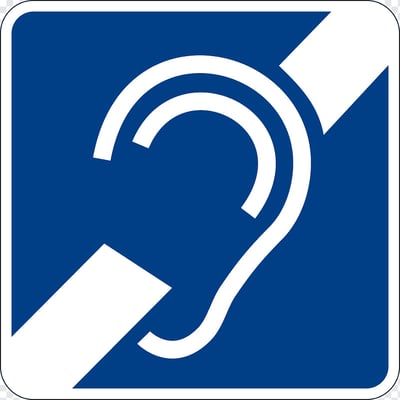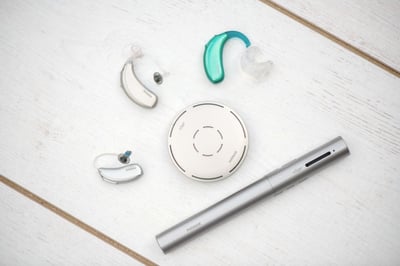Time to Read: 12 minutes
This is part 4 of Christo's April EarTalk webinar. You can find the full video here.
Topics:
- Part 1 What to ask at your first appointment
- Part 2 What to expect from your hearing aids if you're a new to them
- Part 3 Common mistakes first time users (and experienced users) can make
- Part 4 How to get the best from your hearing aids
Getting the best from your hearing aids
 This next point is very relevant to new and existing users - it's about getting the best out of your hearing aids. Here, it's important for you, and also important for your clinician, to help you understand how hearing aids work and how to work with them.
This next point is very relevant to new and existing users - it's about getting the best out of your hearing aids. Here, it's important for you, and also important for your clinician, to help you understand how hearing aids work and how to work with them.
What I mean here is there's a variety of technical capabilities in a hearing aid that could allow you to hear in some situations but not in other situations. If you don't understand those, you might think the hearing aid is not working or, ‘I'm doing something wrong’, meanwhile it's just rules of physics.
One of those is distance.
A hearing aid microphone is sensitive enough to pick up speech but they can't make it hypersensitive because if the little membrane on the microphone is too sensitive, even just air molecules floating through the air hitting that membrane can cause a sound.
So, there's a limit as to how sensitive that can be. That means a hearing aid’s pickup of speech in quiet is limited to about seven metres at most. If someone's talking at a normal level, if they're whispering, it drops in noise.
What most hearing aids do is turn on a second microphone, and by turning on that second microphone, it forms a beam. You can think of a beam coming out the front of your head that focuses forward and that picks up anything that's in front of you louder than anything next to or behind you.
But as soon as it goes into this beam mode, which is typically in noise, the pickup distance reduces from seven metres to only about one and a half to two metres at most. So again, being aware that if there's noise, the hearing aid is doing this, so I shouldn't sit too far away from the person I want to hear.
Hearing Your Best in Noise
 And that comes into noise. If your hearing aid uses directional technology it will use technology like that described above.
And that comes into noise. If your hearing aid uses directional technology it will use technology like that described above.
In addition, there are some hearing aids which now use Artificial Intelligence which works a little bit differently but in noise, typically what you want is to position yourself around a table, say in a restaurant, so most of the background noise is behind you because that's the point of most suppression. The person you want to hear is in front of you and you want to be able to look at the person you want to hear.
It is important when you walk into the restaurant that you look at the seating and think, ‘where's the music stand? Where's the kitchen? Where's the table full of Americans chattering away?’, and keep that behind you.
Similarly you don't want to sit with a wall directly behind the person sitting across from you because all that noise is simply going to bounce off that wall and come back at you. You want a little bit of distance between your table and the next wall to optimise things.
Typically restaurants with carpeting or acoustic tiles will allow you to hear better than restaurants with hard flooring and Ii wish a lot more restaurants would realise that but apparently it's easier and more hygienic to clean a hard floor surface than a carpeted surface, for instance.
Hearing Aid Programs And Features
Another thing to consider is the all program and features on the hearing aid. For instance, some hearing aids might do all that switching and noise automatically. Some hearing aids might have a setting or a program which is accessed through a back button on the hearing aid or remote control to take the hearing aid from allowing you to hear in one situation, to say, turning on the directional microphones or turning onto a music program.
It's important you know when to use those programs and what they are for but it's also important to know when to go out of that program. That's why automatic hearing aids are typically better than manual hearing aids because an automatic hearing aid is always analysing everything around you and changing dynamically.
A manual hearing aid requires you to push go into one mode and out again. If you forget to do that, you're not going to hear well until you change things.
 Other features include telecoils, which is a little electromagnet in the hearing aid allowing you to pick up from loop systems. These are essentially a magnetic loop, a wire plugged into the sound system exerting a magnetic field around certain seats or a certain area like airports. You may have seen the blue ear of a white line through it and a little ‘T’ on it.
Other features include telecoils, which is a little electromagnet in the hearing aid allowing you to pick up from loop systems. These are essentially a magnetic loop, a wire plugged into the sound system exerting a magnetic field around certain seats or a certain area like airports. You may have seen the blue ear of a white line through it and a little ‘T’ on it.
If your hearing aid has telecoil, you can switch to the telecoil program manually and it will pick whatever's coming through that PA system directly in the hearing aids. However, if you go out of that environment, the telecoil program is awful with things like fluorescent lights or shop scanners. You hearing aid will make all sorts of funny noises.
Understand what's available to you and understand what the hearing aids doing in different situations.
These are the sort of things your clinician needs to discuss with you, again relating it back to your needs that you've already originally indicated to them, as well as other needs you may have discovered as you go through the follow-up process.
That process of fitting and follow-up is quite important to get to the nitty-gritty of how things should work and the clinician should discuss these issues with you and help you find the best way of controlling your environment and controlling on your hearing aids to get the best possible out of them.
Again ask for help if you're not hearing well, feel free to ask for repetitions. It's not a sign of weakness, it's a sign that you're really interested in hearing people, but you might also need your partner to help.
Ask for help
Ask for help, ask for repetitions but also ask your partner and even bring your partner to a consultation with the audiologist. Things like knowing not to speak from another room because the hearing aids have that limited pick up. Listening still takes effort and a lot of concentration because of your hearing loss, which means it's tiring. You can't be listening as acutely at all times as someone with normal hearing. Your partner may need to simply get your attention by either calling your name or tapping you on the shoulder before they speak. Doing that will stop them from having to repeat themselves as much.
It's important to engage those who know you well, so they can help you. You can even have a hearing buddy, a spouse, or a friend who sits with you when you're conversing with new people.
They can simply repeat things that are key things that are being said when you're in a conversation so you don't miss out you and don't lose track of a theme if they're switching from one topic to another.
So, it’s very important to discuss your hearing problem with significant others and other people in the environment even if it's to say, ‘look, I've got a hearing problem, so please just make sure you face me when you speak to me because when you look at me, I get forty percent more information from the lips than I do through my hearing aids alone, and I'd really like to hear what you've got to say’.
With hearing aids, there's various accessories that can make things a lot better. As I mentioned before, you get a remote control so if you've got trouble managing the hearing aids through the buttons, you can get a separate remote control to control them which allows you to do it from your pocket. You even have apps which we discussed at the last webinar where you can, through Bluetooth, control the hearing aid but that's not where it ends. There are accessories for television, which essentially connects your hearing aids straight to the television. All the sound that's coming from the TV is being streamed directly into your hearing aids in stereo and you have a beautiful crystal clear sound which is much better than sitting at a distance, or dealing with home acoustics.
 Most of those television accessories still keep the microphones of the hearing aids on, so you can still hear your partner if they comment which allows for that engagement while you're watching television and that is something that headphones, which just block your ears completely, don't allow.
Most of those television accessories still keep the microphones of the hearing aids on, so you can still hear your partner if they comment which allows for that engagement while you're watching television and that is something that headphones, which just block your ears completely, don't allow.
And you do get accessories to connect to mobile phones if your hearing aid doesn't do so directly but an accessory which helps a lot in background noise, or with distance are your remote microphones. Essentially, it's just a little microphone that a person can clip onto the lapel or that you can place on a table or put on a lectern that picks up sound from a distance and streams it straight into your hearing aids.
That sound obviously means speech, so it allows you to hear over much greater distances or in a lot more noise than the hearing aids will allow alone due to those limits of their microphones.
So, speak to your clinician if you have issues and they might recommend an accessory to help with that specific situation as well.
We've got various resources as mentioned previously. We've got our YouTube channel which has a lot of new content on it. We typically update that at least a couple of times a month if not more.
We've got our knowledge base where things like help articles troubleshooting articles appear.
We've got the Value Hearing website which has at least three new blogs every week with the latest information.
You obviously need to communicate with your hearing specialist because they know your situation and they should, if they care, give you the advice as to how to get the best out of your hearing aids and how to address any issues you have.
Again, vitally important that you communicate that with your clinician.
We will be releasing the 2021 Hearing Aid Buyer’s Companion in the next couple of months which will cover a lot of these topics as well and really help you through that journey. So be on the lookout for that and that's it from me today.

